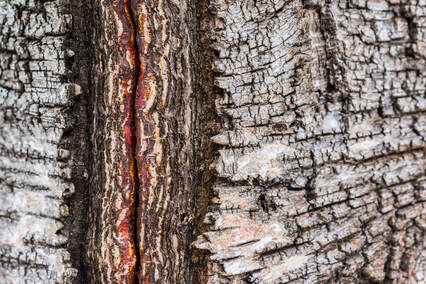 Closeup of damaged birch bark Closeup of damaged birch bark On a cool, sunny day, the sun heats the wood and bark of the tree, making them expand. At night when the temp rapidly drops, the bark cools faster than the wood underneath, making the bark crack vertically as it shrivels over the expanded wood. This is most likely to happen on trees with cuts that have already deteriorated the bark, mainly if they are trees with thin bark or young trees. These cracks are never fatal to the tree and can be fixed. Subzero weather is no one’s favorite time to inspect for issues in the landscape. Often, we don’t see an injury that happens in the wintertime until the springtime. Below zero temps can produce some distinctive issues for landscape tree. One such issue, frost cracks, can severely harm trees. Very low temps in Rochester in the winter can leave trees with vertical cracks. These openings, called frost cracks, can go deep into the wood of a tree. Specific trees tend to be more susceptible to this ailment. It is usually seen in sycamores, but it also happens in apples, maples, horse chestnuts, willows, cherries, walnuts, and lindens. What are the reasons for frost crack in trees? Frost cracks are typically found on trees that are out in the open where the sun shines right on the bark. Cracks are first started in the wintertime when the sun heats the bark and inner wood on the west or south side of the tree, particularly on young trees with thin bark. As the sun is hidden by the clouds or goes down, the temperatures drop rapidly producing shrinkage in the bark while the interior wood takes a long time to contract. This uneven contraction or shrinkage between the interior wood and bark causes the bark and the wood directly below the bark to break. Some professionals at stump removal companies in Rochester believe it from water shifting out of cells and freezing when the temperature suddenly drops. The wood near the surface dwindles as water is lost rapidly while the interior wood isn’t affected. The abrupt change produces pressure between these two zones causing wood cracking. Tip Make your trees less likely to get frost cracks by using accurate pruning methods and steering clear of physical damage to the tree like lawn mower collisions. Comments are closed.
|
AuthorWrite something about yourself. No need to be fancy, just an overview. Archives
December 2020
CategoriesAll Insects & Diseases Questions & Answers Tools & Safety Trees & Landscaping Tree Stump Basics |
- Home
- Services
- About
- Contact
-
Service Areas
- Rochester NY Stump Removal
- Brighton Stump Removal
- Chili Stump Removal
- Churchville Stump Removal
- East Stump Removal
- Fairport Stump Removal
- Farmington Stump Removal
- Gates Stump Removal
- Greece Stump Removal
- Henrietta Stump Removal
- Irondequoit Stump Removal
- North Gates Stump Removal
- Parma Stump Removal
- Penfield Stump Removal
- Perinton Stump Removal
- Pittsford Stump Removal
- Victor Stump Removal
- Webster Stump Removal
- Blog
- Home
- Services
- About
- Contact
-
Service Areas
- Rochester NY Stump Removal
- Brighton Stump Removal
- Chili Stump Removal
- Churchville Stump Removal
- East Stump Removal
- Fairport Stump Removal
- Farmington Stump Removal
- Gates Stump Removal
- Greece Stump Removal
- Henrietta Stump Removal
- Irondequoit Stump Removal
- North Gates Stump Removal
- Parma Stump Removal
- Penfield Stump Removal
- Perinton Stump Removal
- Pittsford Stump Removal
- Victor Stump Removal
- Webster Stump Removal
- Blog
Search by typing & pressing enter

 RSS Feed
RSS Feed